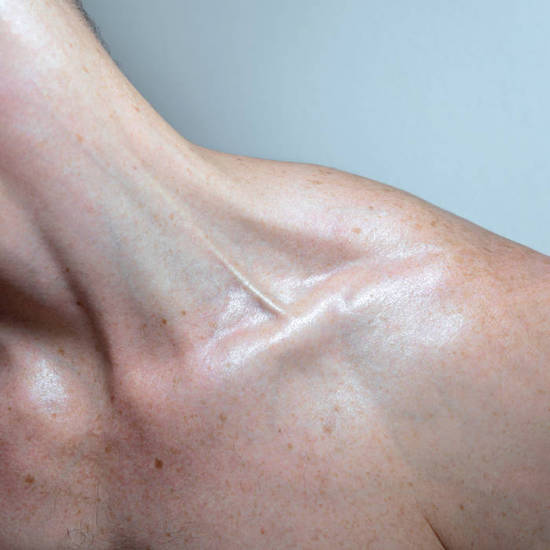A two-year-old performance by Bendik Giske shows the Norwegian saxophonist walking through abandoned hallways at the Berlin HAU Hebbel am Ufer theatre, wrapped in latex. His body blends with his instrument alike a prosthesis. The video, directed by filmmaker Matt Lambert, resembles a crossover between Luc Besson’s mid-90s sci-fi spectacular, The Fifth Element and Leos Carax’s surreal urban fantasy Holy Motors. Every breath, touch, and lick is amplified.
This intensity is heightened even further on Giske’s third self-titled album to become its core design. His 2019 debut Surrender was a drone-based work close to artists such as EMS alumni like Ellen Arkbro or Stockholm label XKatedral. Second album, Cracks, explored the sonic possibilities of the studio and delivered a hefty burst of power-ambient with saxophone arpeggios. But Bendik Giske is just the body and the machine, flesh and metal.
In tracks such as ‘Rhizome’, the clatter of key thuds creates a skeletal rhythmic pattern similar to typewriter banging, or in ‘Rise and Fall’, nasal breaths mount the tension in a subtle hip-hop beat. Giske’s latest music lacks any of the memorable melodies found in his previous output. Instead, it builds on an unembellished approach – with single-take recordings and as little aftertouch as possible – guided by the rhythmologist Beatrice Dillon who served here more as a mentor. Still, the result is far from the raw energy of free improvisation, but then that was never the intention.
Giske built his reputation using a saxophone with a set of contact microphones to amplify the imperfections (part of his revolt against the disciplinary mechanisms of the Scandinavian academic jazz scene where he learnt his craft). Together with the technique of circular breathing, it puts the behind-the-scenes right upfront.
It’s a style that has been popularised by the Canadian saxophonist Colin Stetson, whom Giske rarely mentions, but commentators below his YouTube videos quickly remind him. Nevertheless, it feels like the two musicians approach the technique from different ends. Where Stetson’s latest output is brutal, cinematic, and droney; Giske is more monotonous and almost surgical, as if preparing every single note with a scalpel.
Giske is not a storyteller but operates with the mindset of a conceptual artist, equipped with the intellectual tools of queer theory and dancefloor workouts from the Berlin techno scene. His favourite scholars, Jack Halberstam or José Esteban Muñoz, talk about “the queer art of failure” as a mode of resistance to the heteronormative standards of success. Failure can be a style or a form of escapism from social norms, reminds the latter in his book Cruising Utopia: “Queer failure … is more nearly about escape and a certain virtuosity.”
These figures are embodied in Giske’s style, which can be heard as an “amplified queer body”. The new album puts these ideas to work and traverses percussive accents, from throbbing techno pulse over motorik sax to more unbound syncopations, as in ‘Slipping’ or the propulsive ‘Rush’. There is an enduring sensuality coursing over these seven cyclical tracks paired with a certain quality of proximity and intimacy. With Dillon’s assistance, Bendik Giske fully expresses his vision and transforms it into a powerful statement.


